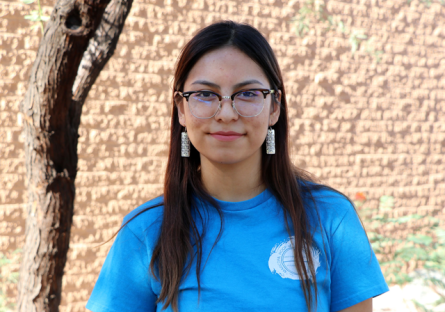
In honor of Native American Heritage Month, Estrella Mountain Community College (EMCC) is turning the spotlight on Niabi Saganitso. The young Navajo hasn’t yet graduated from high school but already has more than 20 college credits under her belt.
Niabi, who’s a senior at Buckeye Union High School, takes part in EMCC’s Hoop of Learning Program. Hoop of Learning is a bridge program designed to encourage students to graduate from high school and go on to college. The program, which supports an average of 20 students per year, is open to Native Americans in ninth through 12th grade.
“The Hoop program benefits students by allowing them to get ahead in their college/educational journey,” said Jennifer Armour, Student Service Specialist Sr.- ACE and Hoop of Learning Coordinator. “Students can earn college credits while in high school, but also get support through the college process. Students can do the exploring part of college while in a supportive environment and feel more confident in their skills and themselves as college students once they enter the college environment on their own.”
Niabi’s been in the program since 10th grade.
“My counselor told me about it,” she said. “She explained the program to me and asked me if I was interested, so I relayed the information to my mom.”
A basic tenet of the program is the importance of young people developing strong positive cultural identities and integrity, so students are encouraged to take classes that focus on Native American history and cultural themes.
“I’m currently taking a class called ‘Hispanic Heritage in the Southwest,’” Niabi said. “Next semester, I’d like to take ‘American Indian Religions.’”
During the school year, Niabi takes one class per semester at EMCC, and then during the summer doubles her course load.
“I could take two classes during the school year, upperclassmen can take up to two, but I have a lot of rigorous, honors courses,” she said. “ I take two classes during the summer, though, because I want to make the best use of my time.”
Did we mention she’s only 16? Niabi skipped sixth grade. She will be one of the youngest freshmen next fall at Northern Arizona University. The obvious overachiever will study nursing on the full-tuition Lumberjack Scholarship.
“Ever since I was little, all of my family is in healthcare, Niabi said. “My mom’s a medical biller, my grandma’s a health technician, so I’ve had a lot of exposure to hospitals. I really like the environment there and I really like what nurses do specifically so I’m really interested in that.”
She also likes the environment in northern Arizona.
“I really like Flagstaff,” she said. “There’s a lot of Native Americans up there and I have family up there.”
Niabi was born in Page while her mother was visiting family on the reservation in Shonto. Niabi and her younger sister, Niema, who will join the Hoop of Learning Program next semester, like to spend summers on the reservation.
“It’s quiet, that’s the best word to describe it,” Niabi said. “Being on the reservation is like going on a hike and having a little house right there. It’s so quiet, it’s deafening.”
She admits that she’s concerned, however, with women and girls who go missing from reservations. On some reservations, women are 10 times as likely to be murdered as the national average, according to the Justice Department. Others simply disappear.
“Being Native American, I have a certain lens that I look through,” she said. “I know what happens on our reservations and I’m more in tune with that. I’m more aware of that when I’m living day to day, because I think about my family on the reservation.”
She’s also well aware of the misconceptions a lot of people have about Native Americans.
“We don’t get free flybys,” she said. “I feel like a lot of people think that we get housing checks or things like that, that we go to college, universities for free, and that’s not the case. We have to work for it like everyone else.”
She hopes people become more educated about Native American tribes and their differences during Native American Heritage Month.
“I hope people learn that Native Americans aren’t like cowboys and Indians,” she said. “They don’t live in teepees. I’ve had people ask me if I live in a teepee.”
She also hopes to spread the word about Rock Your Mocs Day. Every year on Nov. 15, Native Americans are encouraged to wear their moccasins, which are an integral part of their culture.
“It’s so much fun,” she said. “Everyone at school tells me they like my shoes and I get to explain that they’re mocassins.”
Although every tribe has its own style of moccasin, they all share the same purpose: protecting the feet. According to the American Indian Heritage Foundation, moccasins were especially necessary for tribes that migrated frequently and required shoes with strong soles that were able to withstand the outdoor elements. For that reason, the majority of moccasins are made from leather because of its thickness.
Niabi will be the first person in her family to go on to college after graduating from high school. She’s not too nervous, though. The Hoop of Learning Program has prepared her well.
“All of these college planning tips I’ve gotten have helped me regulate my schedule,” Niabi said. “I’ve also met other Native American students who I’m still friends with now, some of whom have already graduated from high school so I can ask them all about college life.”